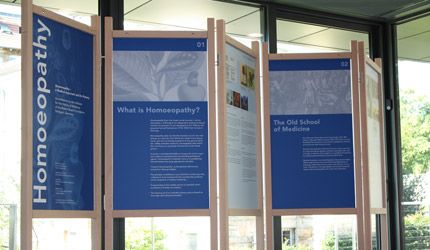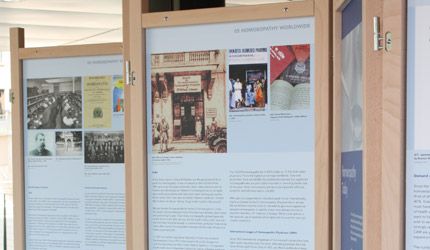Homoeopathy - A Medical Approach and its history
The exhibition illustrates the characteristic features of homoeopathic medicine and explains its therapeutic principles and its holistic view of disease processes. It introduces the similarity rule which is central to homoeopathy as well as the production of homoeopathic medicines from animal preparations, mineral and plant substances.
The journey through history begins with the situation leading up to the first beginnings of homoeopathy. When the physician Samuel Hahnemann developed homoeopathy in the late 18th century, medicine was still far away from its present-day standard of knowledge. Without much insight into the causes of disease physicians harried their patients with bloodletting, enemas and vast amounts of (often harmful) medicaments.
Compared to the medical practices of his time Hahnemann’s approach was revolutionary in that he postulated the exact observation of the patient and the disease picture, the meticulous study of drug effects and, above all, the precise and very low dosage of remedies to avoid any undesired side-effects.
Famous patients from the aristocracy and the art world promoted the dissemination of homoeopathy as their social standing greatly enhanced its public image.
During the cholera epidemic of the 1830s, physicians had the first opportunity to publicly prove the efficacy of the new healing method. Their therapeutic successes which were striking compared to the failures of conventional treatment contributed immensely to the popularity of homoeopathy.
In the face of much resistance and hostility from the orthodox medical fraternity, homoeopathy spread in the first half of the 19th century, first in Germany and then worldwide. With their idealism and financial support a number of wealthy sponsors and patrons made it possible to set up homoeopathic hospitals. In the late 19th century, the first few factories developed from the small homoeopathic producers and soon dominated the homoeopathic pharmaceutical market.
The 200-year history of homoeopathy also includes the Nazi period, when many homoeopaths hoped for the fulfilment of their long-harboured dreams of public recognition.
The exhibition follows the worldwide development of homoeopathy in detail paying particular attention to the diverse ways in which it evolved in the various European countries up to its present-day boom that also extends to Central and Eastern Europe. The success of the North American homoeopaths and how it was received worldwide was an important influence right up to the early 20th century. Nowadays, it is the renaissance of homoeopathy in South America that excites much interest. Special attention is given to Brazil where homoeopathy is recognized as part of the ‘integrative national health system’. The development in Asia is demonstrated by the example of recent innovative streams, such as in Japan, and the situation in India where homoeopathy is holding a strong position being fully included in the national health care provision. India boasts the widest dissemination and the best institutional recognition of homoeopathy worldwide.
The historical review closes with a look at the situation of homoeopathy today. Since the 1980s, homoeopathy has experienced a considerable global upsurge. In the course of its 200-year history various regional schools of homoeopathy have emerged. The efficacy of the high potencies has remained controversial until today. The exhibition therefore also gives an account of the current research into this question and the outcomes of the research into health care provision. Special indication areas for homoeopathy and patient needs are described in conclusion.
How much space is needed for the exhibition?
The exhibition occupies an area of approx. 40-80 square meters. The flexible display stands allow for various set-ups and can easily be adjusted to the space in question. The panels need to be accessible from both sides.
What costs are involved?
A borrowing fee of €100.00 is payable in advance. The borrower commits to taking out ‘nail to nail’ insurance to the value of €15,000.00 for the loan period. The borrower is liable for any damage to the exhibition. A copy of the insurance policy must be submitted in advance.
Is there any information material?
There is
A flyer for exhibition visitors €0.40
A poster €3.50
An exhibition banner (available on request)
A short guide with the main texts €2.50
These materials can be ordered from the Institute for the History of Medicine.
Who can answer my questions?
The contact person for booking the exhibition, signing an agreement and for the technical procedure is Steffi Berg. See right column for details.
How many components does the exhibition consist of once it is set up?
There are 10 display stands (2.22 x 0.80 m) that are grouped and to which 10 exhibition panels (1.20 x 0.65 m) can be attached. The whole system can be arranged in a line, but also in other formations such as a Z shape or an open rectangle. It is important that the panels can be seen from both sides.
The height of the uniform display stands is adjustable between 2.22 and 2.27 m to make up for uneven ground surfaces.
How long does it take to set up the exhibition?
The exhibition can be set up in one to three hours, depending on technical skill.
Which tools are needed for setting up the exhibition?
A screwdriver (ideally electrical) is needed to open the chests. The tools needed for installing the exhibition are contained in the chests (1 slotted and 1 Philips screwdriver, 1 Allen key, 1 flat spanner (17 mm) to adjust the height.
How much space is needed for storage?
For the exhibition, a storage space of approx. 2.40 m (length), 0.90 m (height) and 1.00 m (width) is needed.
How is the exhibition supplied?
The exhibition arrives in three wooden chests, 1 chest for the 10 panels, 2 chests for the display stands.
Are there any installation instructions?
Because the installation is so simple, no instructions are supplied, but the following points need to be considered:
1. The bottom height has to be set with a flat spanner using the adjusting nuts provided. The feet must not be turned!
2. To insert the picture panels into the frames, one only needs to loosen the two screws in the top rail of the frame.
Size and weight of the individual components?
1 chest (length: 1.46 m, width: 0.77 m, height: 0.15 m): 70 kg
2 chests (length: 2.40 m, width: 0.90 m, height: 0.37 m): 140 kg
Total weight: 350 kg
What vehicle is needed to transport them?
A van is sufficient.
What is needed for loading and unloading?
Because of the weight of the chests, four strong people are necessary for loading and unloading.
Contact person for booking the exhibition
Archivist Dr. phil. Marion Baschin
Institut für Geschichte der Medizin
Straußweg 17
D-70184 Stuttgart
Tel.: 0711 / 46 08 41 73 (direkt)
Tel.: 0711 / 46 08 41 71 und 72
Sekretariat)
Fax: 0711 / 46 08 41 81
marion.baschin@igm-bosch.de
Institut für Geschichte der Medizin
Straußweg 17
D-70184 Stuttgart
Tel.: 0711 / 46 08 41 65
Fax: 0711 / 46 08 41 81
sandra.doelker@igm-bosch.de





